BS2558 - The Economic Impact of BREXIT on the UK: A Detailed Analysis
VerifiedAdded on 2022/08/15
|12
|3172
|14
Essay
AI Summary
This essay examines the economic impact of BREXIT on the UK, considering its effects on labor, finance, capital, and immigration. It uses economic theories and models of trade and migration to evaluate the situation, highlighting the uncertainty and potential instability following BREXIT. The analysis covers the impact on foreign direct investments, trade, financial markets, investments, and employment, with a focus on how BREXIT has altered the UK's trading relationships and economic policies. The essay also addresses the immigration concerns that influenced the BREXIT decision and their implications for public services and the labor market. The paper concludes by emphasizing the need for internal alignment and sustainable economic policies to mitigate the negative impacts of BREXIT and ensure long-term economic success for the UK.
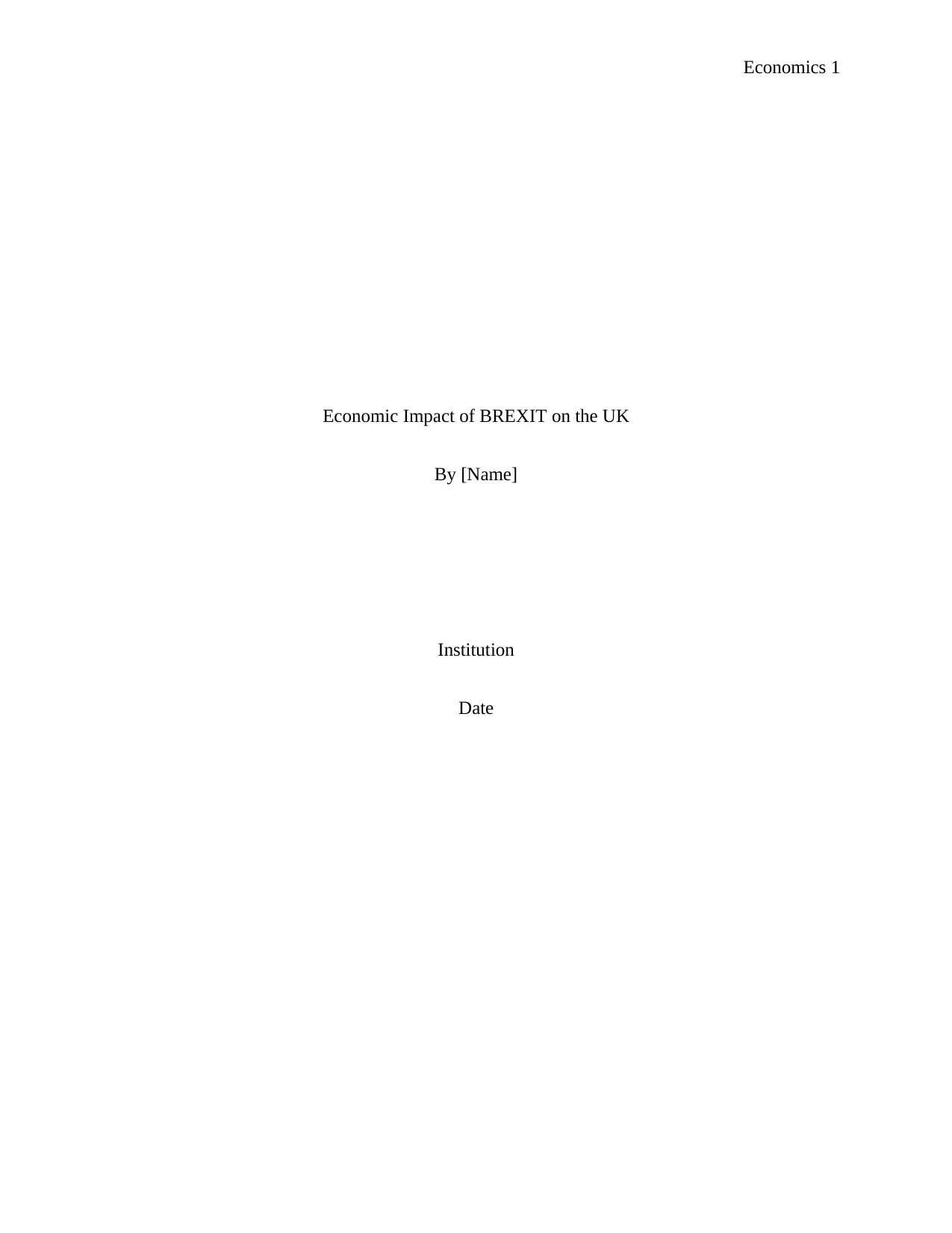
Economics 1
Economic Impact of BREXIT on the UK
By [Name]
Institution
Date
Economic Impact of BREXIT on the UK
By [Name]
Institution
Date
Paraphrase This Document
Need a fresh take? Get an instant paraphrase of this document with our AI Paraphraser
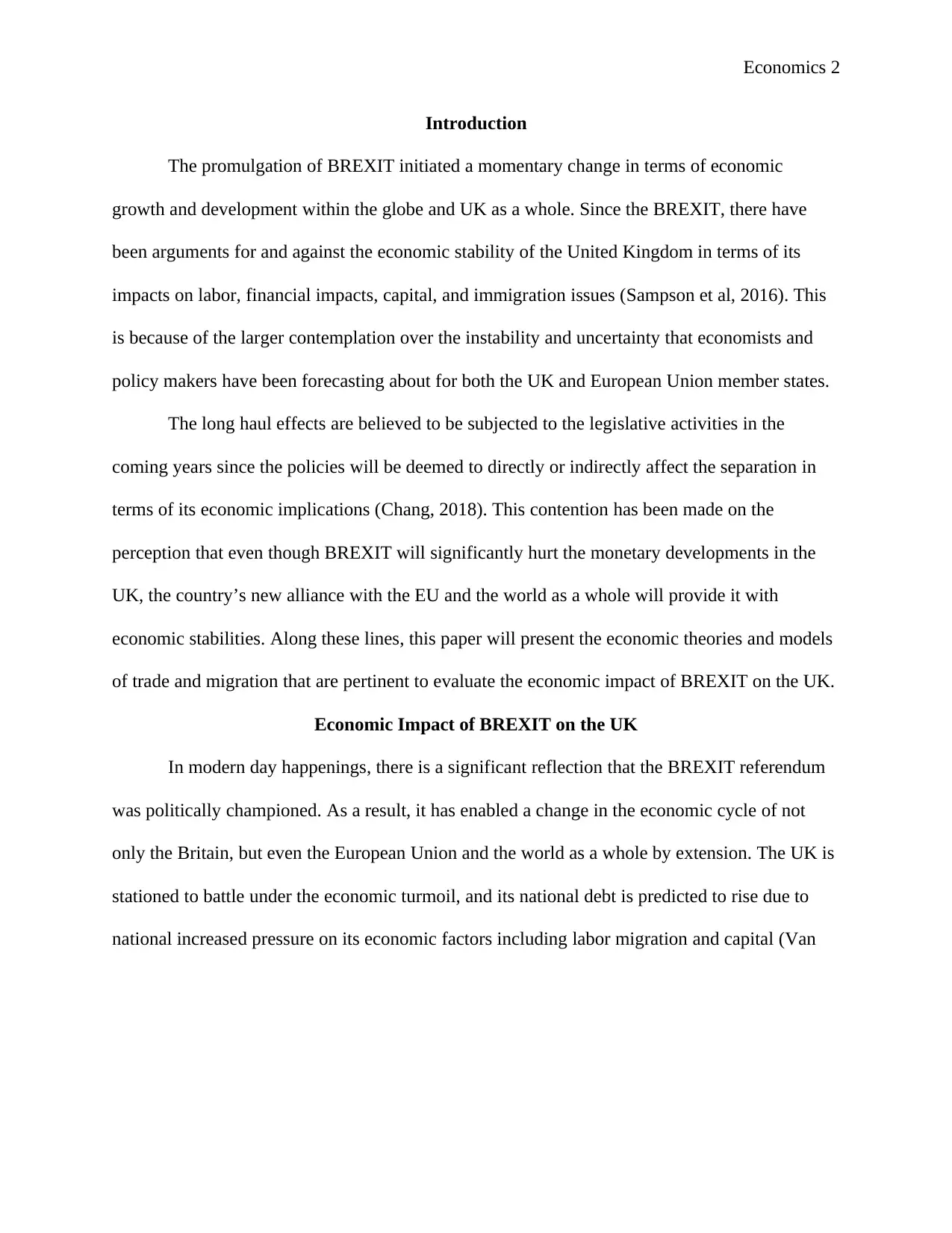
Economics 2
Introduction
The promulgation of BREXIT initiated a momentary change in terms of economic
growth and development within the globe and UK as a whole. Since the BREXIT, there have
been arguments for and against the economic stability of the United Kingdom in terms of its
impacts on labor, financial impacts, capital, and immigration issues (Sampson et al, 2016). This
is because of the larger contemplation over the instability and uncertainty that economists and
policy makers have been forecasting about for both the UK and European Union member states.
The long haul effects are believed to be subjected to the legislative activities in the
coming years since the policies will be deemed to directly or indirectly affect the separation in
terms of its economic implications (Chang, 2018). This contention has been made on the
perception that even though BREXIT will significantly hurt the monetary developments in the
UK, the country’s new alliance with the EU and the world as a whole will provide it with
economic stabilities. Along these lines, this paper will present the economic theories and models
of trade and migration that are pertinent to evaluate the economic impact of BREXIT on the UK.
Economic Impact of BREXIT on the UK
In modern day happenings, there is a significant reflection that the BREXIT referendum
was politically championed. As a result, it has enabled a change in the economic cycle of not
only the Britain, but even the European Union and the world as a whole by extension. The UK is
stationed to battle under the economic turmoil, and its national debt is predicted to rise due to
national increased pressure on its economic factors including labor migration and capital (Van
Introduction
The promulgation of BREXIT initiated a momentary change in terms of economic
growth and development within the globe and UK as a whole. Since the BREXIT, there have
been arguments for and against the economic stability of the United Kingdom in terms of its
impacts on labor, financial impacts, capital, and immigration issues (Sampson et al, 2016). This
is because of the larger contemplation over the instability and uncertainty that economists and
policy makers have been forecasting about for both the UK and European Union member states.
The long haul effects are believed to be subjected to the legislative activities in the
coming years since the policies will be deemed to directly or indirectly affect the separation in
terms of its economic implications (Chang, 2018). This contention has been made on the
perception that even though BREXIT will significantly hurt the monetary developments in the
UK, the country’s new alliance with the EU and the world as a whole will provide it with
economic stabilities. Along these lines, this paper will present the economic theories and models
of trade and migration that are pertinent to evaluate the economic impact of BREXIT on the UK.
Economic Impact of BREXIT on the UK
In modern day happenings, there is a significant reflection that the BREXIT referendum
was politically championed. As a result, it has enabled a change in the economic cycle of not
only the Britain, but even the European Union and the world as a whole by extension. The UK is
stationed to battle under the economic turmoil, and its national debt is predicted to rise due to
national increased pressure on its economic factors including labor migration and capital (Van
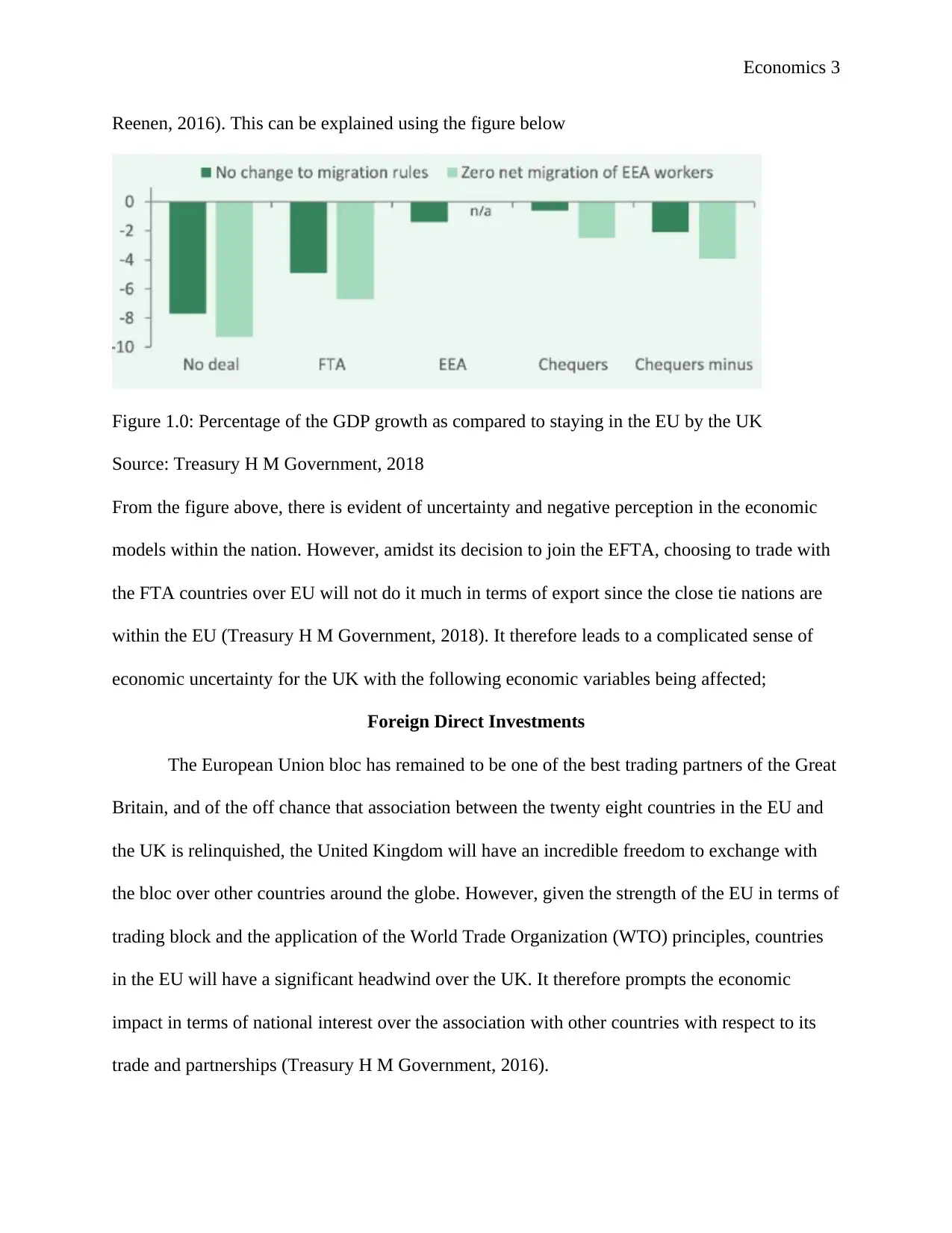
Economics 3
Reenen, 2016). This can be explained using the figure below
Figure 1.0: Percentage of the GDP growth as compared to staying in the EU by the UK
Source: Treasury H M Government, 2018
From the figure above, there is evident of uncertainty and negative perception in the economic
models within the nation. However, amidst its decision to join the EFTA, choosing to trade with
the FTA countries over EU will not do it much in terms of export since the close tie nations are
within the EU (Treasury H M Government, 2018). It therefore leads to a complicated sense of
economic uncertainty for the UK with the following economic variables being affected;
Foreign Direct Investments
The European Union bloc has remained to be one of the best trading partners of the Great
Britain, and of the off chance that association between the twenty eight countries in the EU and
the UK is relinquished, the United Kingdom will have an incredible freedom to exchange with
the bloc over other countries around the globe. However, given the strength of the EU in terms of
trading block and the application of the World Trade Organization (WTO) principles, countries
in the EU will have a significant headwind over the UK. It therefore prompts the economic
impact in terms of national interest over the association with other countries with respect to its
trade and partnerships (Treasury H M Government, 2016).
Reenen, 2016). This can be explained using the figure below
Figure 1.0: Percentage of the GDP growth as compared to staying in the EU by the UK
Source: Treasury H M Government, 2018
From the figure above, there is evident of uncertainty and negative perception in the economic
models within the nation. However, amidst its decision to join the EFTA, choosing to trade with
the FTA countries over EU will not do it much in terms of export since the close tie nations are
within the EU (Treasury H M Government, 2018). It therefore leads to a complicated sense of
economic uncertainty for the UK with the following economic variables being affected;
Foreign Direct Investments
The European Union bloc has remained to be one of the best trading partners of the Great
Britain, and of the off chance that association between the twenty eight countries in the EU and
the UK is relinquished, the United Kingdom will have an incredible freedom to exchange with
the bloc over other countries around the globe. However, given the strength of the EU in terms of
trading block and the application of the World Trade Organization (WTO) principles, countries
in the EU will have a significant headwind over the UK. It therefore prompts the economic
impact in terms of national interest over the association with other countries with respect to its
trade and partnerships (Treasury H M Government, 2016).
⊘ This is a preview!⊘
Do you want full access?
Subscribe today to unlock all pages.

Trusted by 1+ million students worldwide
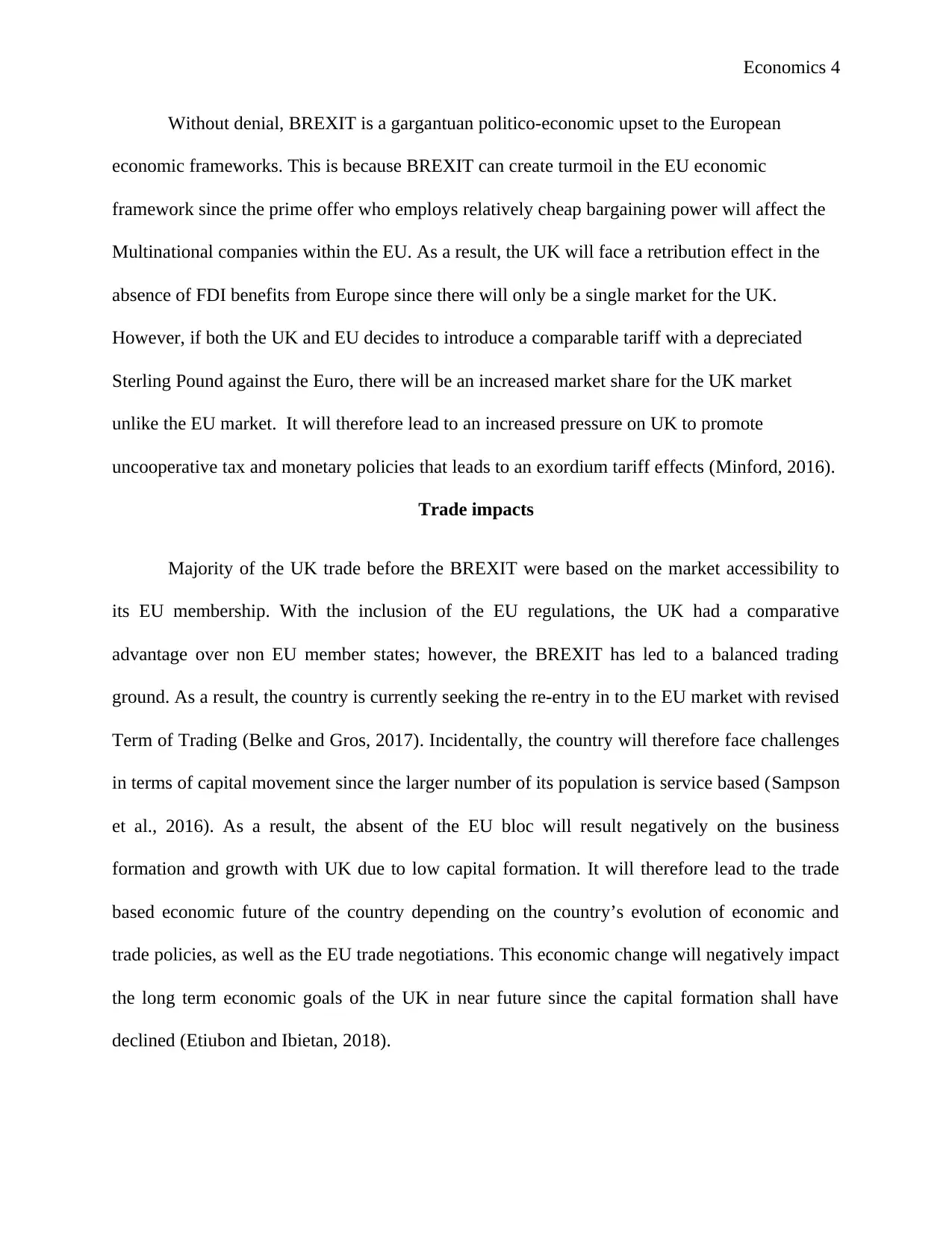
Economics 4
Without denial, BREXIT is a gargantuan politico-economic upset to the European
economic frameworks. This is because BREXIT can create turmoil in the EU economic
framework since the prime offer who employs relatively cheap bargaining power will affect the
Multinational companies within the EU. As a result, the UK will face a retribution effect in the
absence of FDI benefits from Europe since there will only be a single market for the UK.
However, if both the UK and EU decides to introduce a comparable tariff with a depreciated
Sterling Pound against the Euro, there will be an increased market share for the UK market
unlike the EU market. It will therefore lead to an increased pressure on UK to promote
uncooperative tax and monetary policies that leads to an exordium tariff effects (Minford, 2016).
Trade impacts
Majority of the UK trade before the BREXIT were based on the market accessibility to
its EU membership. With the inclusion of the EU regulations, the UK had a comparative
advantage over non EU member states; however, the BREXIT has led to a balanced trading
ground. As a result, the country is currently seeking the re-entry in to the EU market with revised
Term of Trading (Belke and Gros, 2017). Incidentally, the country will therefore face challenges
in terms of capital movement since the larger number of its population is service based (Sampson
et al., 2016). As a result, the absent of the EU bloc will result negatively on the business
formation and growth with UK due to low capital formation. It will therefore lead to the trade
based economic future of the country depending on the country’s evolution of economic and
trade policies, as well as the EU trade negotiations. This economic change will negatively impact
the long term economic goals of the UK in near future since the capital formation shall have
declined (Etiubon and Ibietan, 2018).
Without denial, BREXIT is a gargantuan politico-economic upset to the European
economic frameworks. This is because BREXIT can create turmoil in the EU economic
framework since the prime offer who employs relatively cheap bargaining power will affect the
Multinational companies within the EU. As a result, the UK will face a retribution effect in the
absence of FDI benefits from Europe since there will only be a single market for the UK.
However, if both the UK and EU decides to introduce a comparable tariff with a depreciated
Sterling Pound against the Euro, there will be an increased market share for the UK market
unlike the EU market. It will therefore lead to an increased pressure on UK to promote
uncooperative tax and monetary policies that leads to an exordium tariff effects (Minford, 2016).
Trade impacts
Majority of the UK trade before the BREXIT were based on the market accessibility to
its EU membership. With the inclusion of the EU regulations, the UK had a comparative
advantage over non EU member states; however, the BREXIT has led to a balanced trading
ground. As a result, the country is currently seeking the re-entry in to the EU market with revised
Term of Trading (Belke and Gros, 2017). Incidentally, the country will therefore face challenges
in terms of capital movement since the larger number of its population is service based (Sampson
et al., 2016). As a result, the absent of the EU bloc will result negatively on the business
formation and growth with UK due to low capital formation. It will therefore lead to the trade
based economic future of the country depending on the country’s evolution of economic and
trade policies, as well as the EU trade negotiations. This economic change will negatively impact
the long term economic goals of the UK in near future since the capital formation shall have
declined (Etiubon and Ibietan, 2018).
Paraphrase This Document
Need a fresh take? Get an instant paraphrase of this document with our AI Paraphraser
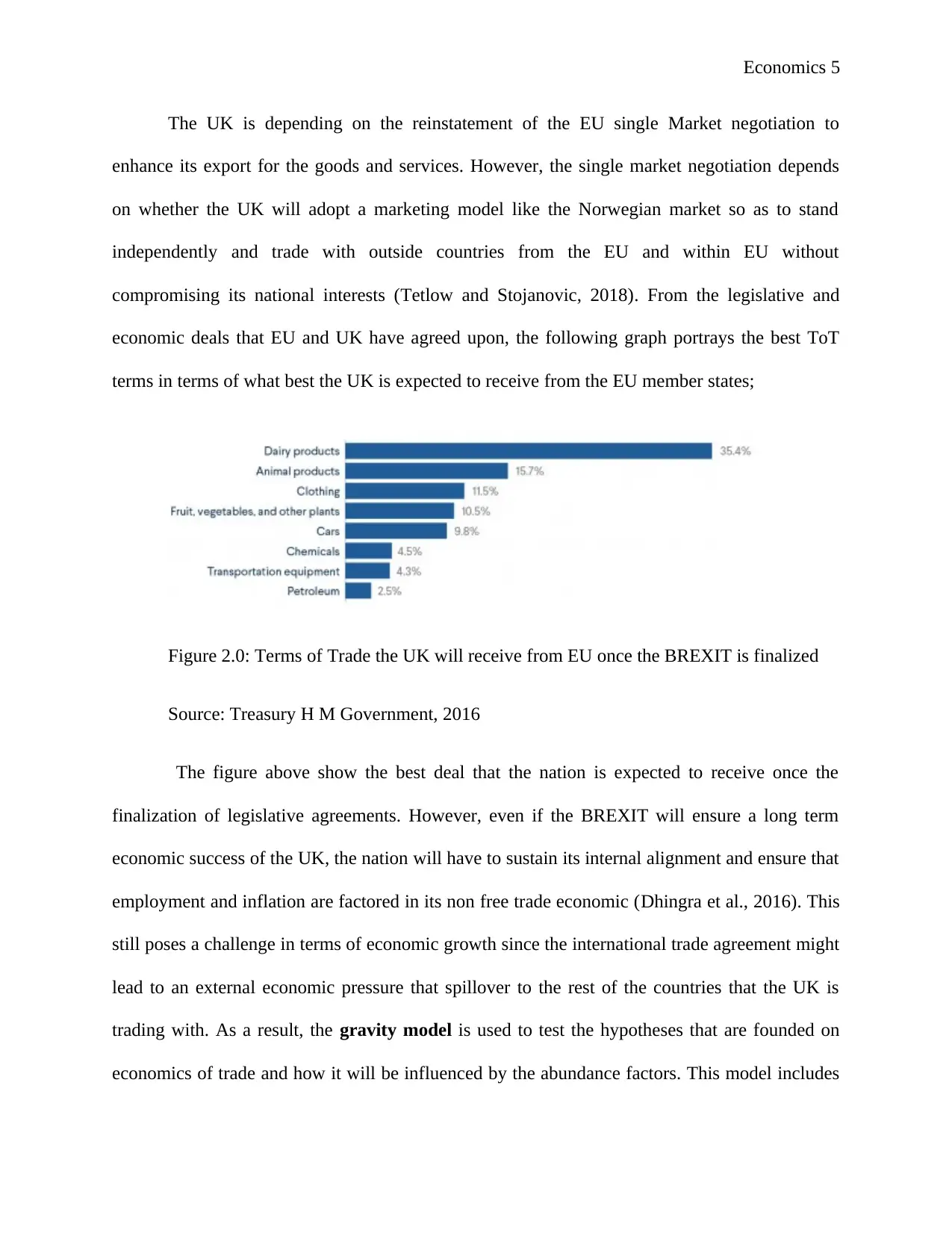
Economics 5
The UK is depending on the reinstatement of the EU single Market negotiation to
enhance its export for the goods and services. However, the single market negotiation depends
on whether the UK will adopt a marketing model like the Norwegian market so as to stand
independently and trade with outside countries from the EU and within EU without
compromising its national interests (Tetlow and Stojanovic, 2018). From the legislative and
economic deals that EU and UK have agreed upon, the following graph portrays the best ToT
terms in terms of what best the UK is expected to receive from the EU member states;
Figure 2.0: Terms of Trade the UK will receive from EU once the BREXIT is finalized
Source: Treasury H M Government, 2016
The figure above show the best deal that the nation is expected to receive once the
finalization of legislative agreements. However, even if the BREXIT will ensure a long term
economic success of the UK, the nation will have to sustain its internal alignment and ensure that
employment and inflation are factored in its non free trade economic (Dhingra et al., 2016). This
still poses a challenge in terms of economic growth since the international trade agreement might
lead to an external economic pressure that spillover to the rest of the countries that the UK is
trading with. As a result, the gravity model is used to test the hypotheses that are founded on
economics of trade and how it will be influenced by the abundance factors. This model includes
The UK is depending on the reinstatement of the EU single Market negotiation to
enhance its export for the goods and services. However, the single market negotiation depends
on whether the UK will adopt a marketing model like the Norwegian market so as to stand
independently and trade with outside countries from the EU and within EU without
compromising its national interests (Tetlow and Stojanovic, 2018). From the legislative and
economic deals that EU and UK have agreed upon, the following graph portrays the best ToT
terms in terms of what best the UK is expected to receive from the EU member states;
Figure 2.0: Terms of Trade the UK will receive from EU once the BREXIT is finalized
Source: Treasury H M Government, 2016
The figure above show the best deal that the nation is expected to receive once the
finalization of legislative agreements. However, even if the BREXIT will ensure a long term
economic success of the UK, the nation will have to sustain its internal alignment and ensure that
employment and inflation are factored in its non free trade economic (Dhingra et al., 2016). This
still poses a challenge in terms of economic growth since the international trade agreement might
lead to an external economic pressure that spillover to the rest of the countries that the UK is
trading with. As a result, the gravity model is used to test the hypotheses that are founded on
economics of trade and how it will be influenced by the abundance factors. This model includes
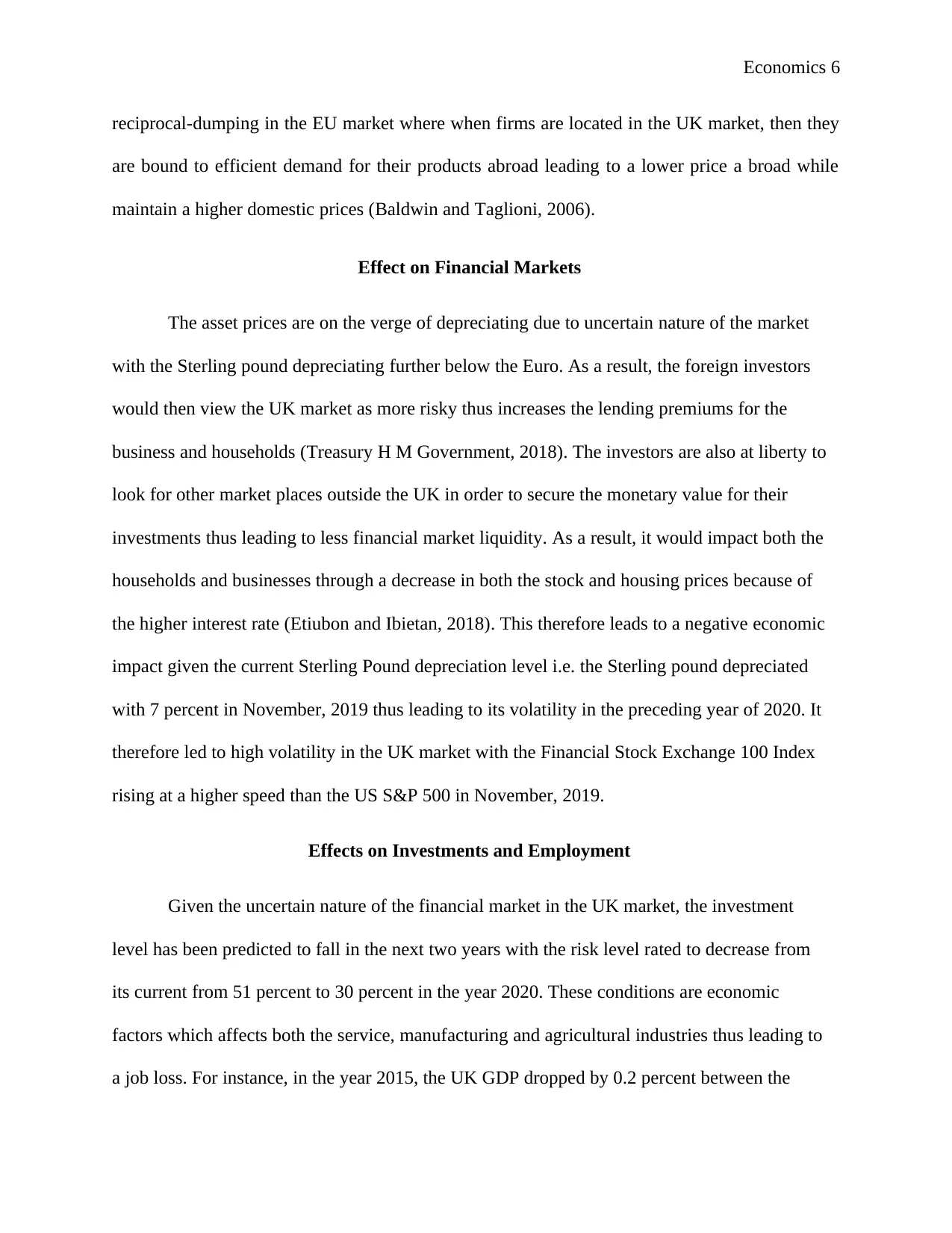
Economics 6
reciprocal-dumping in the EU market where when firms are located in the UK market, then they
are bound to efficient demand for their products abroad leading to a lower price a broad while
maintain a higher domestic prices (Baldwin and Taglioni, 2006).
Effect on Financial Markets
The asset prices are on the verge of depreciating due to uncertain nature of the market
with the Sterling pound depreciating further below the Euro. As a result, the foreign investors
would then view the UK market as more risky thus increases the lending premiums for the
business and households (Treasury H M Government, 2018). The investors are also at liberty to
look for other market places outside the UK in order to secure the monetary value for their
investments thus leading to less financial market liquidity. As a result, it would impact both the
households and businesses through a decrease in both the stock and housing prices because of
the higher interest rate (Etiubon and Ibietan, 2018). This therefore leads to a negative economic
impact given the current Sterling Pound depreciation level i.e. the Sterling pound depreciated
with 7 percent in November, 2019 thus leading to its volatility in the preceding year of 2020. It
therefore led to high volatility in the UK market with the Financial Stock Exchange 100 Index
rising at a higher speed than the US S&P 500 in November, 2019.
Effects on Investments and Employment
Given the uncertain nature of the financial market in the UK market, the investment
level has been predicted to fall in the next two years with the risk level rated to decrease from
its current from 51 percent to 30 percent in the year 2020. These conditions are economic
factors which affects both the service, manufacturing and agricultural industries thus leading to
a job loss. For instance, in the year 2015, the UK GDP dropped by 0.2 percent between the
reciprocal-dumping in the EU market where when firms are located in the UK market, then they
are bound to efficient demand for their products abroad leading to a lower price a broad while
maintain a higher domestic prices (Baldwin and Taglioni, 2006).
Effect on Financial Markets
The asset prices are on the verge of depreciating due to uncertain nature of the market
with the Sterling pound depreciating further below the Euro. As a result, the foreign investors
would then view the UK market as more risky thus increases the lending premiums for the
business and households (Treasury H M Government, 2018). The investors are also at liberty to
look for other market places outside the UK in order to secure the monetary value for their
investments thus leading to less financial market liquidity. As a result, it would impact both the
households and businesses through a decrease in both the stock and housing prices because of
the higher interest rate (Etiubon and Ibietan, 2018). This therefore leads to a negative economic
impact given the current Sterling Pound depreciation level i.e. the Sterling pound depreciated
with 7 percent in November, 2019 thus leading to its volatility in the preceding year of 2020. It
therefore led to high volatility in the UK market with the Financial Stock Exchange 100 Index
rising at a higher speed than the US S&P 500 in November, 2019.
Effects on Investments and Employment
Given the uncertain nature of the financial market in the UK market, the investment
level has been predicted to fall in the next two years with the risk level rated to decrease from
its current from 51 percent to 30 percent in the year 2020. These conditions are economic
factors which affects both the service, manufacturing and agricultural industries thus leading to
a job loss. For instance, in the year 2015, the UK GDP dropped by 0.2 percent between the
⊘ This is a preview!⊘
Do you want full access?
Subscribe today to unlock all pages.

Trusted by 1+ million students worldwide
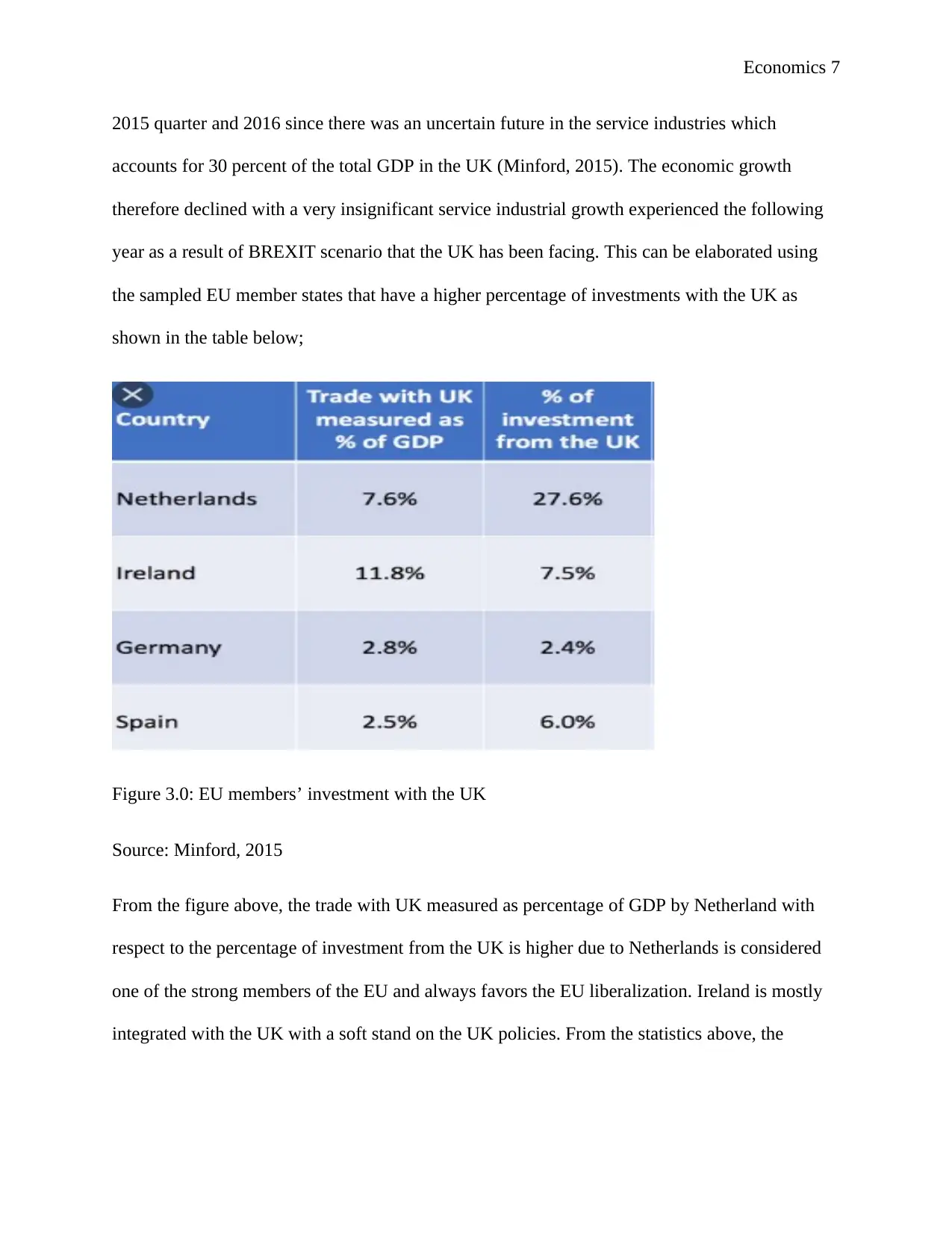
Economics 7
2015 quarter and 2016 since there was an uncertain future in the service industries which
accounts for 30 percent of the total GDP in the UK (Minford, 2015). The economic growth
therefore declined with a very insignificant service industrial growth experienced the following
year as a result of BREXIT scenario that the UK has been facing. This can be elaborated using
the sampled EU member states that have a higher percentage of investments with the UK as
shown in the table below;
Figure 3.0: EU members’ investment with the UK
Source: Minford, 2015
From the figure above, the trade with UK measured as percentage of GDP by Netherland with
respect to the percentage of investment from the UK is higher due to Netherlands is considered
one of the strong members of the EU and always favors the EU liberalization. Ireland is mostly
integrated with the UK with a soft stand on the UK policies. From the statistics above, the
2015 quarter and 2016 since there was an uncertain future in the service industries which
accounts for 30 percent of the total GDP in the UK (Minford, 2015). The economic growth
therefore declined with a very insignificant service industrial growth experienced the following
year as a result of BREXIT scenario that the UK has been facing. This can be elaborated using
the sampled EU member states that have a higher percentage of investments with the UK as
shown in the table below;
Figure 3.0: EU members’ investment with the UK
Source: Minford, 2015
From the figure above, the trade with UK measured as percentage of GDP by Netherland with
respect to the percentage of investment from the UK is higher due to Netherlands is considered
one of the strong members of the EU and always favors the EU liberalization. Ireland is mostly
integrated with the UK with a soft stand on the UK policies. From the statistics above, the
Paraphrase This Document
Need a fresh take? Get an instant paraphrase of this document with our AI Paraphraser
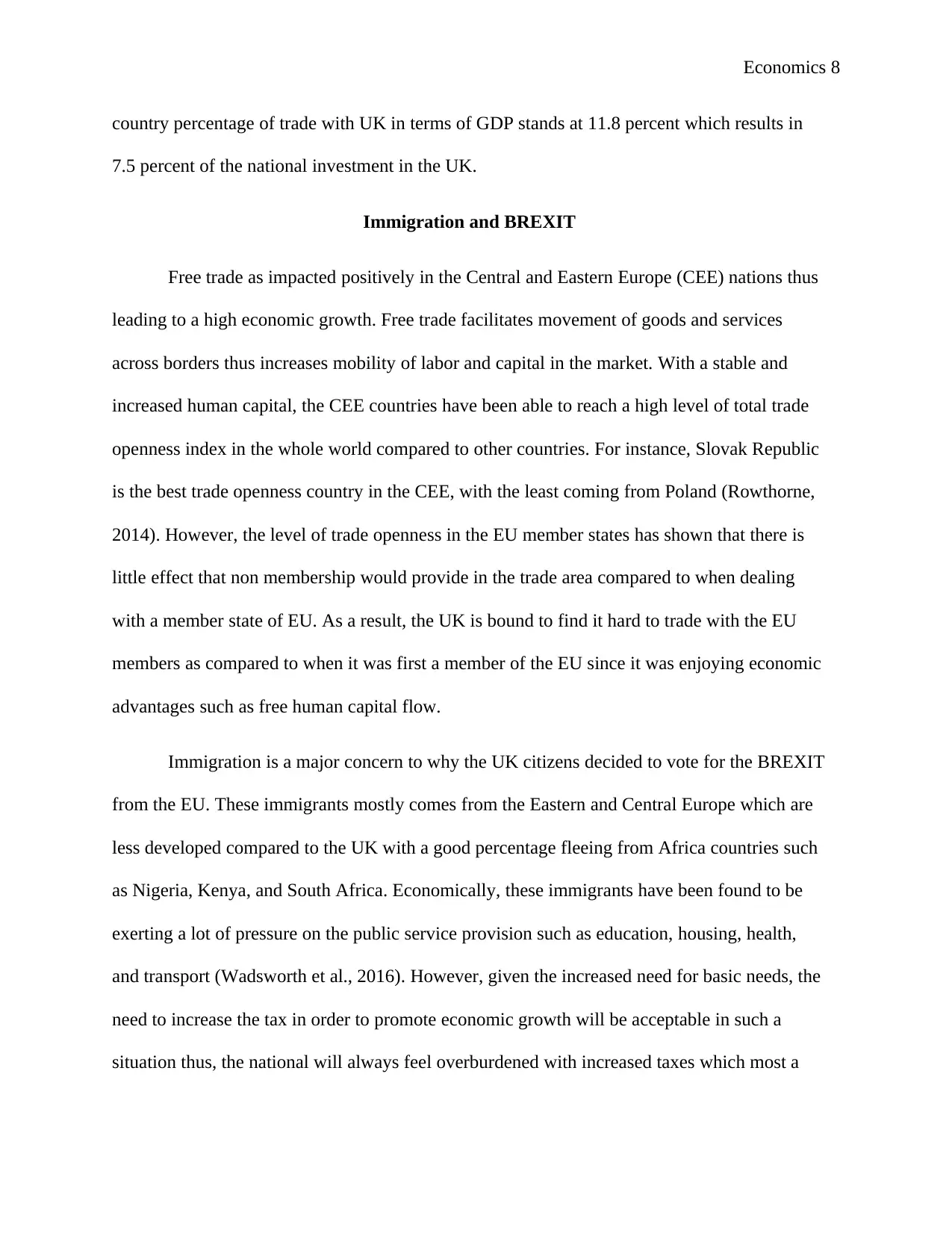
Economics 8
country percentage of trade with UK in terms of GDP stands at 11.8 percent which results in
7.5 percent of the national investment in the UK.
Immigration and BREXIT
Free trade as impacted positively in the Central and Eastern Europe (CEE) nations thus
leading to a high economic growth. Free trade facilitates movement of goods and services
across borders thus increases mobility of labor and capital in the market. With a stable and
increased human capital, the CEE countries have been able to reach a high level of total trade
openness index in the whole world compared to other countries. For instance, Slovak Republic
is the best trade openness country in the CEE, with the least coming from Poland (Rowthorne,
2014). However, the level of trade openness in the EU member states has shown that there is
little effect that non membership would provide in the trade area compared to when dealing
with a member state of EU. As a result, the UK is bound to find it hard to trade with the EU
members as compared to when it was first a member of the EU since it was enjoying economic
advantages such as free human capital flow.
Immigration is a major concern to why the UK citizens decided to vote for the BREXIT
from the EU. These immigrants mostly comes from the Eastern and Central Europe which are
less developed compared to the UK with a good percentage fleeing from Africa countries such
as Nigeria, Kenya, and South Africa. Economically, these immigrants have been found to be
exerting a lot of pressure on the public service provision such as education, housing, health,
and transport (Wadsworth et al., 2016). However, given the increased need for basic needs, the
need to increase the tax in order to promote economic growth will be acceptable in such a
situation thus, the national will always feel overburdened with increased taxes which most a
country percentage of trade with UK in terms of GDP stands at 11.8 percent which results in
7.5 percent of the national investment in the UK.
Immigration and BREXIT
Free trade as impacted positively in the Central and Eastern Europe (CEE) nations thus
leading to a high economic growth. Free trade facilitates movement of goods and services
across borders thus increases mobility of labor and capital in the market. With a stable and
increased human capital, the CEE countries have been able to reach a high level of total trade
openness index in the whole world compared to other countries. For instance, Slovak Republic
is the best trade openness country in the CEE, with the least coming from Poland (Rowthorne,
2014). However, the level of trade openness in the EU member states has shown that there is
little effect that non membership would provide in the trade area compared to when dealing
with a member state of EU. As a result, the UK is bound to find it hard to trade with the EU
members as compared to when it was first a member of the EU since it was enjoying economic
advantages such as free human capital flow.
Immigration is a major concern to why the UK citizens decided to vote for the BREXIT
from the EU. These immigrants mostly comes from the Eastern and Central Europe which are
less developed compared to the UK with a good percentage fleeing from Africa countries such
as Nigeria, Kenya, and South Africa. Economically, these immigrants have been found to be
exerting a lot of pressure on the public service provision such as education, housing, health,
and transport (Wadsworth et al., 2016). However, given the increased need for basic needs, the
need to increase the tax in order to promote economic growth will be acceptable in such a
situation thus, the national will always feel overburdened with increased taxes which most a
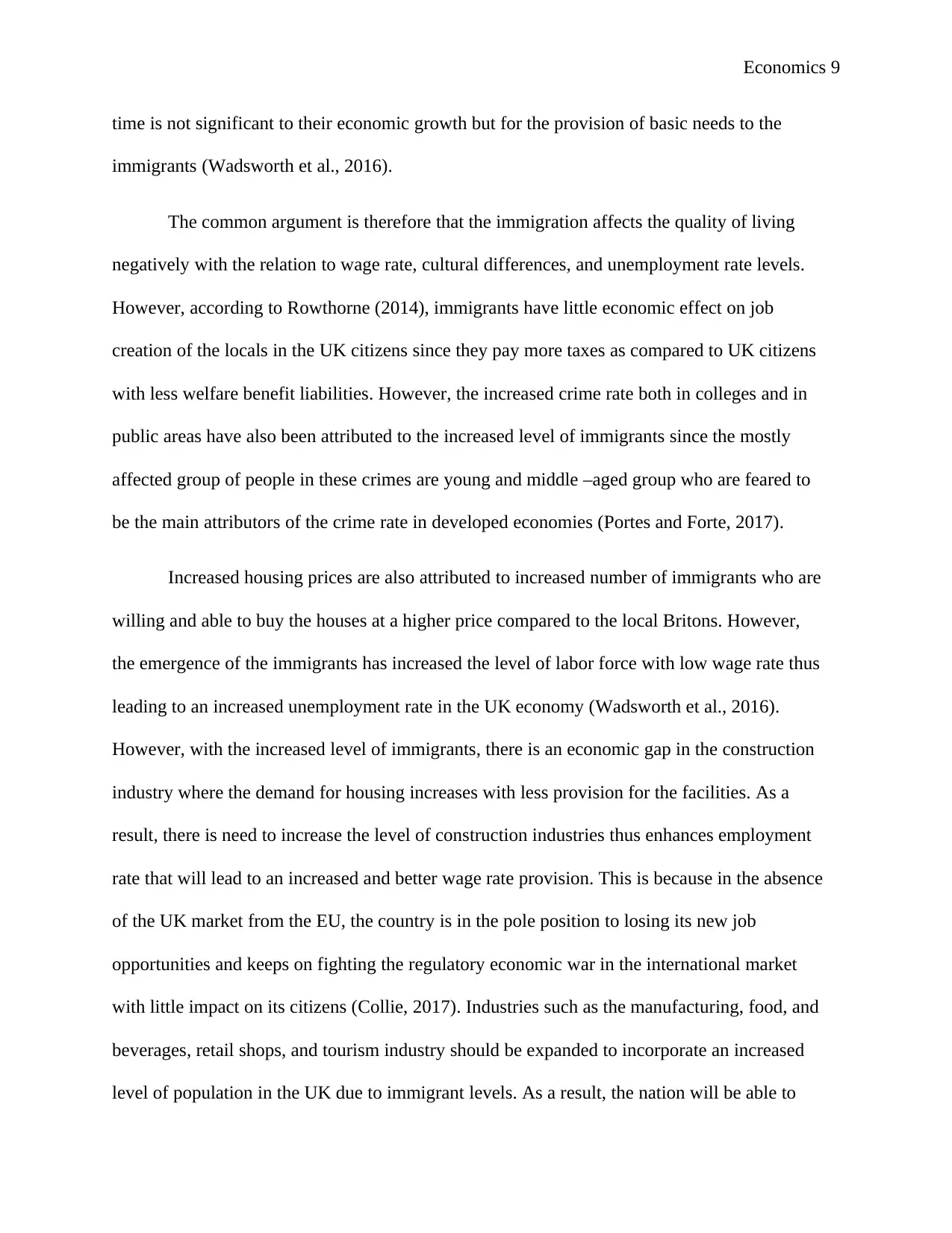
Economics 9
time is not significant to their economic growth but for the provision of basic needs to the
immigrants (Wadsworth et al., 2016).
The common argument is therefore that the immigration affects the quality of living
negatively with the relation to wage rate, cultural differences, and unemployment rate levels.
However, according to Rowthorne (2014), immigrants have little economic effect on job
creation of the locals in the UK citizens since they pay more taxes as compared to UK citizens
with less welfare benefit liabilities. However, the increased crime rate both in colleges and in
public areas have also been attributed to the increased level of immigrants since the mostly
affected group of people in these crimes are young and middle –aged group who are feared to
be the main attributors of the crime rate in developed economies (Portes and Forte, 2017).
Increased housing prices are also attributed to increased number of immigrants who are
willing and able to buy the houses at a higher price compared to the local Britons. However,
the emergence of the immigrants has increased the level of labor force with low wage rate thus
leading to an increased unemployment rate in the UK economy (Wadsworth et al., 2016).
However, with the increased level of immigrants, there is an economic gap in the construction
industry where the demand for housing increases with less provision for the facilities. As a
result, there is need to increase the level of construction industries thus enhances employment
rate that will lead to an increased and better wage rate provision. This is because in the absence
of the UK market from the EU, the country is in the pole position to losing its new job
opportunities and keeps on fighting the regulatory economic war in the international market
with little impact on its citizens (Collie, 2017). Industries such as the manufacturing, food, and
beverages, retail shops, and tourism industry should be expanded to incorporate an increased
level of population in the UK due to immigrant levels. As a result, the nation will be able to
time is not significant to their economic growth but for the provision of basic needs to the
immigrants (Wadsworth et al., 2016).
The common argument is therefore that the immigration affects the quality of living
negatively with the relation to wage rate, cultural differences, and unemployment rate levels.
However, according to Rowthorne (2014), immigrants have little economic effect on job
creation of the locals in the UK citizens since they pay more taxes as compared to UK citizens
with less welfare benefit liabilities. However, the increased crime rate both in colleges and in
public areas have also been attributed to the increased level of immigrants since the mostly
affected group of people in these crimes are young and middle –aged group who are feared to
be the main attributors of the crime rate in developed economies (Portes and Forte, 2017).
Increased housing prices are also attributed to increased number of immigrants who are
willing and able to buy the houses at a higher price compared to the local Britons. However,
the emergence of the immigrants has increased the level of labor force with low wage rate thus
leading to an increased unemployment rate in the UK economy (Wadsworth et al., 2016).
However, with the increased level of immigrants, there is an economic gap in the construction
industry where the demand for housing increases with less provision for the facilities. As a
result, there is need to increase the level of construction industries thus enhances employment
rate that will lead to an increased and better wage rate provision. This is because in the absence
of the UK market from the EU, the country is in the pole position to losing its new job
opportunities and keeps on fighting the regulatory economic war in the international market
with little impact on its citizens (Collie, 2017). Industries such as the manufacturing, food, and
beverages, retail shops, and tourism industry should be expanded to incorporate an increased
level of population in the UK due to immigrant levels. As a result, the nation will be able to
⊘ This is a preview!⊘
Do you want full access?
Subscribe today to unlock all pages.

Trusted by 1+ million students worldwide
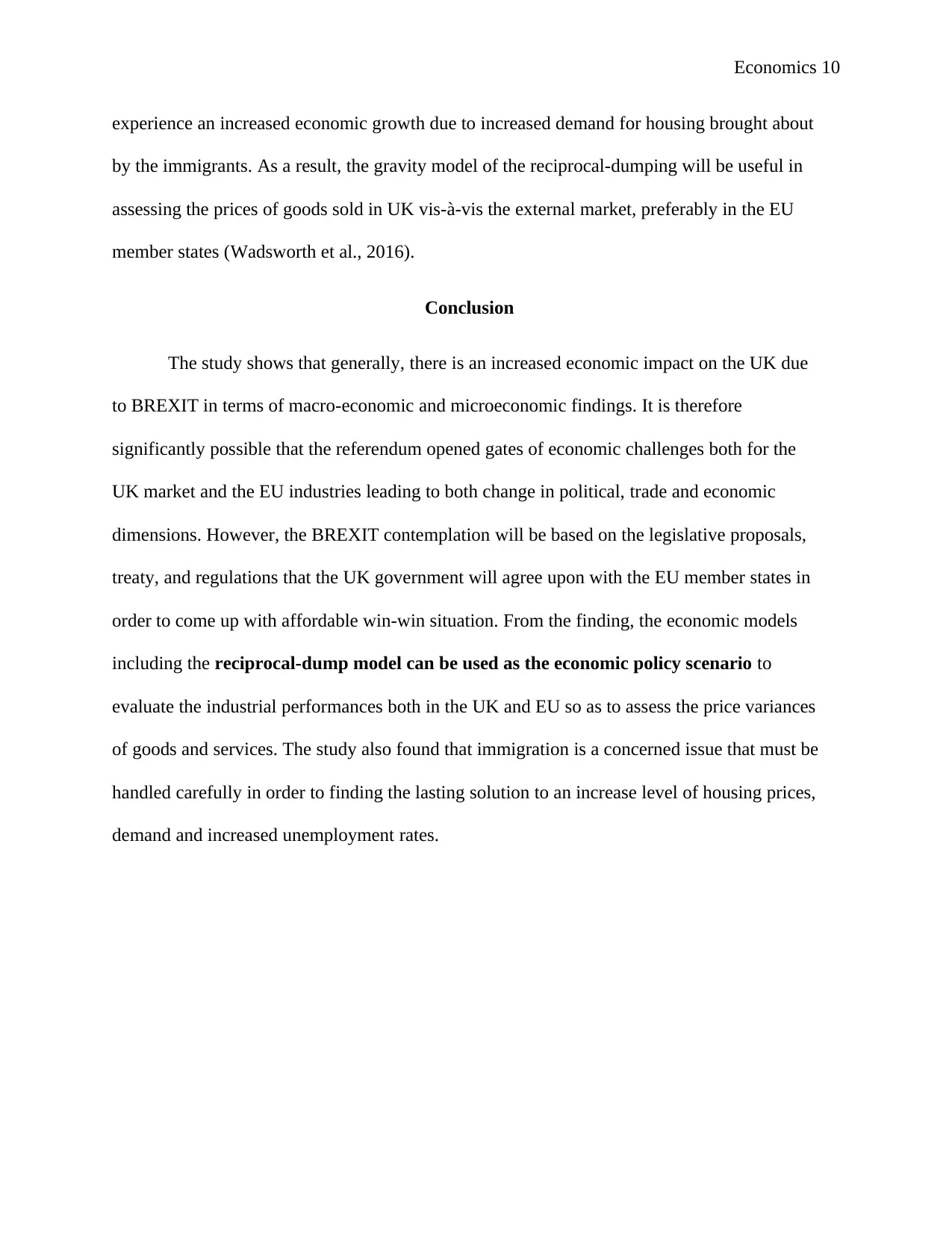
Economics 10
experience an increased economic growth due to increased demand for housing brought about
by the immigrants. As a result, the gravity model of the reciprocal-dumping will be useful in
assessing the prices of goods sold in UK vis-à-vis the external market, preferably in the EU
member states (Wadsworth et al., 2016).
Conclusion
The study shows that generally, there is an increased economic impact on the UK due
to BREXIT in terms of macro-economic and microeconomic findings. It is therefore
significantly possible that the referendum opened gates of economic challenges both for the
UK market and the EU industries leading to both change in political, trade and economic
dimensions. However, the BREXIT contemplation will be based on the legislative proposals,
treaty, and regulations that the UK government will agree upon with the EU member states in
order to come up with affordable win-win situation. From the finding, the economic models
including the reciprocal-dump model can be used as the economic policy scenario to
evaluate the industrial performances both in the UK and EU so as to assess the price variances
of goods and services. The study also found that immigration is a concerned issue that must be
handled carefully in order to finding the lasting solution to an increase level of housing prices,
demand and increased unemployment rates.
experience an increased economic growth due to increased demand for housing brought about
by the immigrants. As a result, the gravity model of the reciprocal-dumping will be useful in
assessing the prices of goods sold in UK vis-à-vis the external market, preferably in the EU
member states (Wadsworth et al., 2016).
Conclusion
The study shows that generally, there is an increased economic impact on the UK due
to BREXIT in terms of macro-economic and microeconomic findings. It is therefore
significantly possible that the referendum opened gates of economic challenges both for the
UK market and the EU industries leading to both change in political, trade and economic
dimensions. However, the BREXIT contemplation will be based on the legislative proposals,
treaty, and regulations that the UK government will agree upon with the EU member states in
order to come up with affordable win-win situation. From the finding, the economic models
including the reciprocal-dump model can be used as the economic policy scenario to
evaluate the industrial performances both in the UK and EU so as to assess the price variances
of goods and services. The study also found that immigration is a concerned issue that must be
handled carefully in order to finding the lasting solution to an increase level of housing prices,
demand and increased unemployment rates.
Paraphrase This Document
Need a fresh take? Get an instant paraphrase of this document with our AI Paraphraser
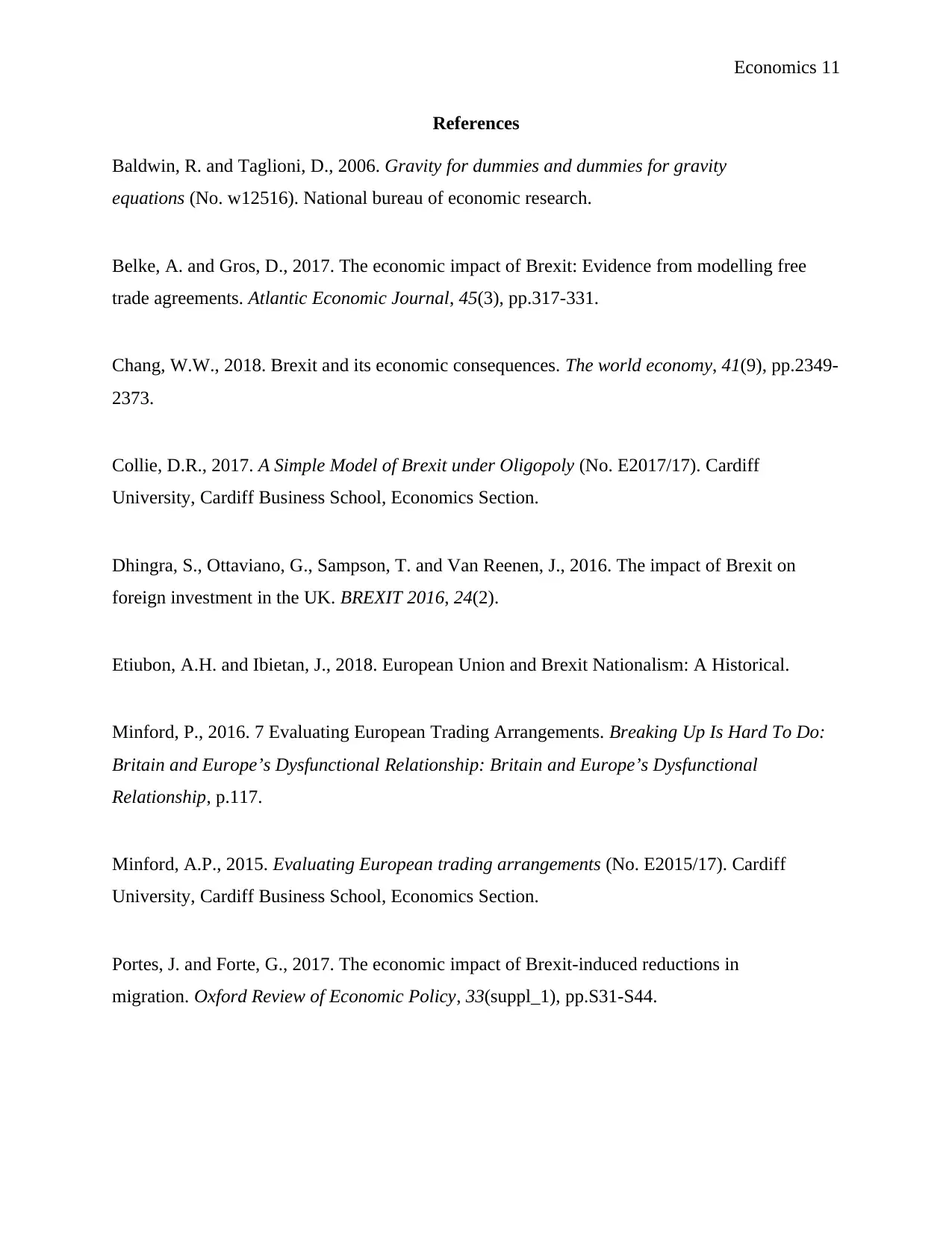
Economics 11
References
Baldwin, R. and Taglioni, D., 2006. Gravity for dummies and dummies for gravity
equations (No. w12516). National bureau of economic research.
Belke, A. and Gros, D., 2017. The economic impact of Brexit: Evidence from modelling free
trade agreements. Atlantic Economic Journal, 45(3), pp.317-331.
Chang, W.W., 2018. Brexit and its economic consequences. The world economy, 41(9), pp.2349-
2373.
Collie, D.R., 2017. A Simple Model of Brexit under Oligopoly (No. E2017/17). Cardiff
University, Cardiff Business School, Economics Section.
Dhingra, S., Ottaviano, G., Sampson, T. and Van Reenen, J., 2016. The impact of Brexit on
foreign investment in the UK. BREXIT 2016, 24(2).
Etiubon, A.H. and Ibietan, J., 2018. European Union and Brexit Nationalism: A Historical.
Minford, P., 2016. 7 Evaluating European Trading Arrangements. Breaking Up Is Hard To Do:
Britain and Europe’s Dysfunctional Relationship: Britain and Europe’s Dysfunctional
Relationship, p.117.
Minford, A.P., 2015. Evaluating European trading arrangements (No. E2015/17). Cardiff
University, Cardiff Business School, Economics Section.
Portes, J. and Forte, G., 2017. The economic impact of Brexit-induced reductions in
migration. Oxford Review of Economic Policy, 33(suppl_1), pp.S31-S44.
References
Baldwin, R. and Taglioni, D., 2006. Gravity for dummies and dummies for gravity
equations (No. w12516). National bureau of economic research.
Belke, A. and Gros, D., 2017. The economic impact of Brexit: Evidence from modelling free
trade agreements. Atlantic Economic Journal, 45(3), pp.317-331.
Chang, W.W., 2018. Brexit and its economic consequences. The world economy, 41(9), pp.2349-
2373.
Collie, D.R., 2017. A Simple Model of Brexit under Oligopoly (No. E2017/17). Cardiff
University, Cardiff Business School, Economics Section.
Dhingra, S., Ottaviano, G., Sampson, T. and Van Reenen, J., 2016. The impact of Brexit on
foreign investment in the UK. BREXIT 2016, 24(2).
Etiubon, A.H. and Ibietan, J., 2018. European Union and Brexit Nationalism: A Historical.
Minford, P., 2016. 7 Evaluating European Trading Arrangements. Breaking Up Is Hard To Do:
Britain and Europe’s Dysfunctional Relationship: Britain and Europe’s Dysfunctional
Relationship, p.117.
Minford, A.P., 2015. Evaluating European trading arrangements (No. E2015/17). Cardiff
University, Cardiff Business School, Economics Section.
Portes, J. and Forte, G., 2017. The economic impact of Brexit-induced reductions in
migration. Oxford Review of Economic Policy, 33(suppl_1), pp.S31-S44.
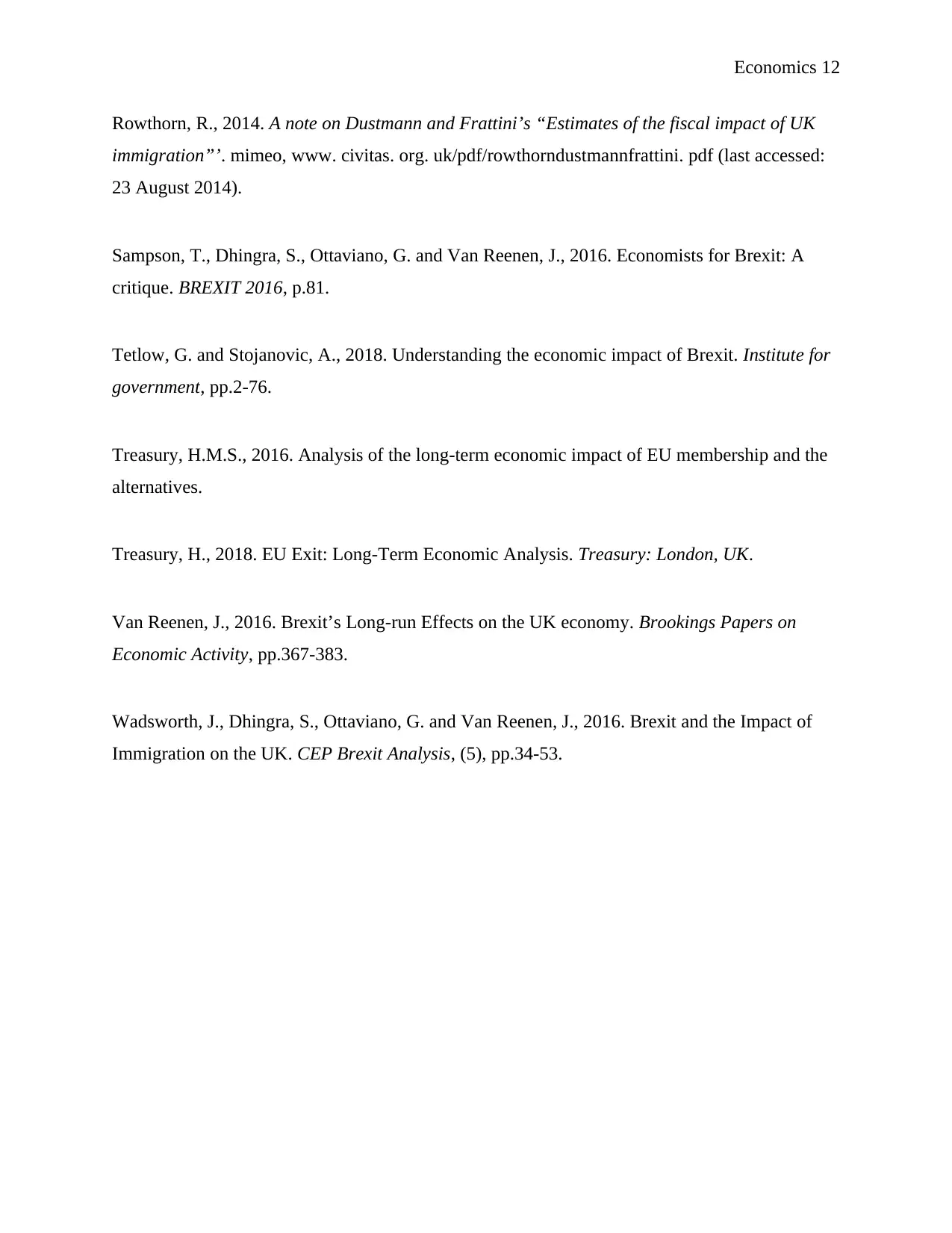
Economics 12
Rowthorn, R., 2014. A note on Dustmann and Frattini’s “Estimates of the fiscal impact of UK
immigration”’. mimeo, www. civitas. org. uk/pdf/rowthorndustmannfrattini. pdf (last accessed:
23 August 2014).
Sampson, T., Dhingra, S., Ottaviano, G. and Van Reenen, J., 2016. Economists for Brexit: A
critique. BREXIT 2016, p.81.
Tetlow, G. and Stojanovic, A., 2018. Understanding the economic impact of Brexit. Institute for
government, pp.2-76.
Treasury, H.M.S., 2016. Analysis of the long-term economic impact of EU membership and the
alternatives.
Treasury, H., 2018. EU Exit: Long-Term Economic Analysis. Treasury: London, UK.
Van Reenen, J., 2016. Brexit’s Long-run Effects on the UK economy. Brookings Papers on
Economic Activity, pp.367-383.
Wadsworth, J., Dhingra, S., Ottaviano, G. and Van Reenen, J., 2016. Brexit and the Impact of
Immigration on the UK. CEP Brexit Analysis, (5), pp.34-53.
Rowthorn, R., 2014. A note on Dustmann and Frattini’s “Estimates of the fiscal impact of UK
immigration”’. mimeo, www. civitas. org. uk/pdf/rowthorndustmannfrattini. pdf (last accessed:
23 August 2014).
Sampson, T., Dhingra, S., Ottaviano, G. and Van Reenen, J., 2016. Economists for Brexit: A
critique. BREXIT 2016, p.81.
Tetlow, G. and Stojanovic, A., 2018. Understanding the economic impact of Brexit. Institute for
government, pp.2-76.
Treasury, H.M.S., 2016. Analysis of the long-term economic impact of EU membership and the
alternatives.
Treasury, H., 2018. EU Exit: Long-Term Economic Analysis. Treasury: London, UK.
Van Reenen, J., 2016. Brexit’s Long-run Effects on the UK economy. Brookings Papers on
Economic Activity, pp.367-383.
Wadsworth, J., Dhingra, S., Ottaviano, G. and Van Reenen, J., 2016. Brexit and the Impact of
Immigration on the UK. CEP Brexit Analysis, (5), pp.34-53.
⊘ This is a preview!⊘
Do you want full access?
Subscribe today to unlock all pages.

Trusted by 1+ million students worldwide
1 out of 12
Related Documents
Your All-in-One AI-Powered Toolkit for Academic Success.
+13062052269
info@desklib.com
Available 24*7 on WhatsApp / Email
![[object Object]](/_next/static/media/star-bottom.7253800d.svg)
Unlock your academic potential
Copyright © 2020–2025 A2Z Services. All Rights Reserved. Developed and managed by ZUCOL.





